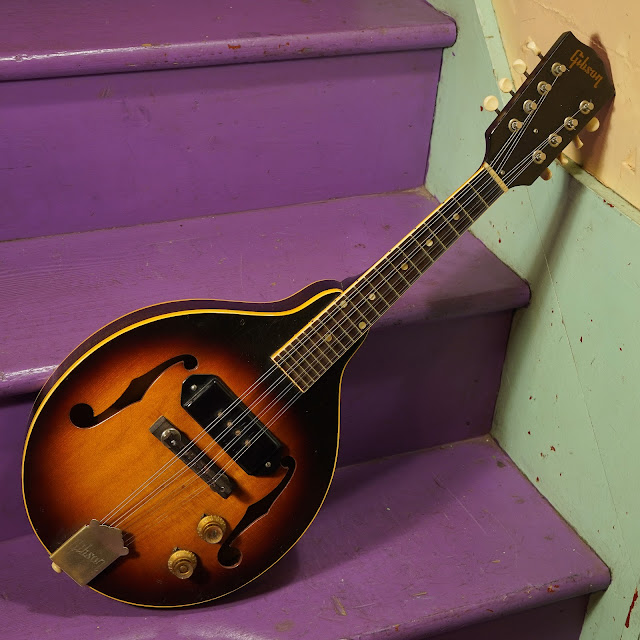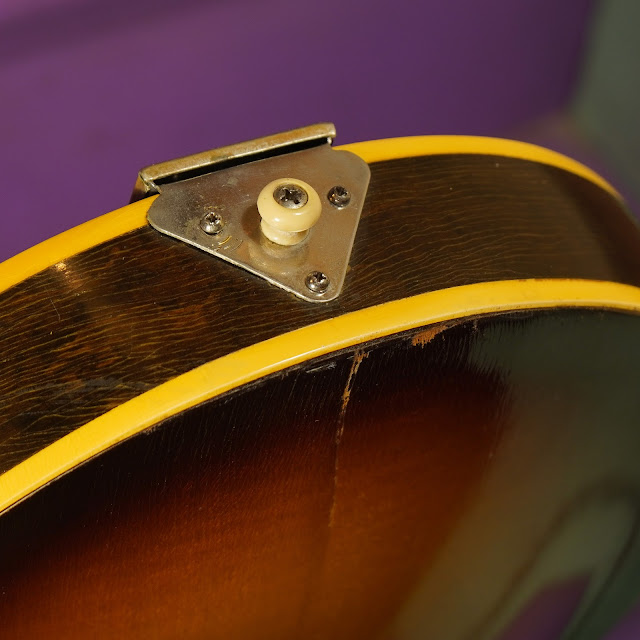1962 Gibson EM-150 Electric Mandolin
Update 2022: well, Gibson's wonderful plan of cutting a hole in the braces to fit the P90 was still yielding dividends in the structure changing (action lowering), so when this guy came back in for resale just recently, I added some soundposts under the bridge feet to lock it into stability (it's been spot-on for a couple weeks, now) and changed the risers under the pickup into rubber risers that hold it at a better angle. All good, now! I've taken fresh photos and updated the description where necessary. Now back to that original description from 2020...
My crazy collection compatriot Wayne dropped this mandolin off a bit ago and I finally got it wrapped-up. My initial reaction is -- woah, that's killer! The adjustable poles of the original P90 pickup allow one to really get proper string-to-string volume balance and, being a P90, it has nice, fat mids that make this fun to pick on, too. It works really well played clean for a more "swingy" sound or, when driven, something pretty aggressive.
When it came in it had very burst seams at the endblock from, apparently, moisture damage. The back was "exploded" away from the endblock area by over 2" of swell. A lot of heavy clamping solved that, but the other "aging" damage was on the top, where it had collapsed into a flattish profile in the middle. The braces are all intact, however, and so that part of the "settling in" I left alone and worked around, instead.
What's most surprising about this instrument is that, unlike Gibson's other hollowbody electric instruments (which tended to use ply mahogany or ply maple for the bodies), this one was made with solid wood for the top, back, and sides.
Repairs included: seam repairs, a fret level/dress, modification of the replacement bridge (better seating, compensation, and a reinforcement steel bar to keep it stable), cleaning, and setup.
Setup notes: the neck is straight, the truss rod works, and action is a hair under 1/16" at the 12th fret bass and treble. Strings are stainless-steel wound and gauges 35w, 24w, 13, 9 as I recall.
Scale length: 13 7/8"
Nut width: 1 1/4"
String spacing at nut: 1"
String spacing at bridge: 1 5/8"
Body length: 13 1/4"
Lower bout width: 10"
Side depth at deepest: 1 3/4" + arched top/back
Top wood: solid spruce
Back/sides wood: solid maple
Neck wood: mahogany
Fretboard: rosewood
Bridge: replacement adjustable rosewood
Neck feel: slim C, flat board
Condition notes: general usewear throughout, finish fading and weather-checking as usual, replacement bridge, top collapsed but stable (now with pine-block soundposts added), small mucked-up area of finish on rear seam near endpin. The quirky bridge has a metal support bar I added under its top which is hilarious but works. I thought of adding a new, traditional-style bridge to it, but balked at the idea of having to cut the bass to fit the changed top profile. This one works just fine! It's cute because whoever put it on used some cork padding on the wings of it to conform to the top more easily... a good idea. There are some rubber "risers" under the pickup's cover which hold it closer to the strings and more horizontal.
It comes with: an original case.





















Comments